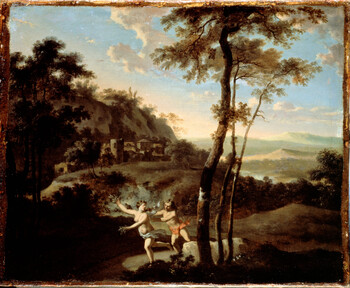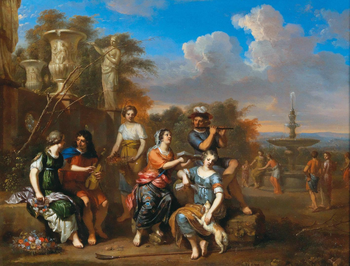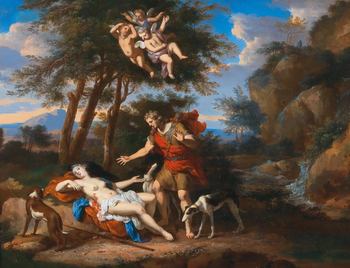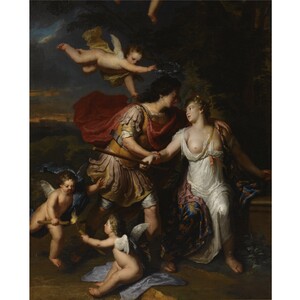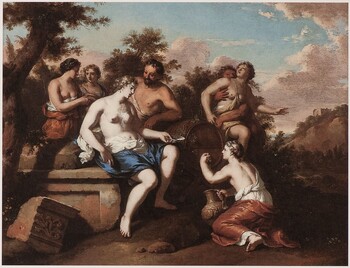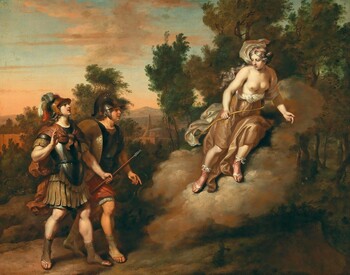3.000 €
Perseus and Andromeda
Oil on canvas : 93,8 X 93,1 cm
Signed middle left “G.Hoet”
Unframed
In short
Our mythological painting must, judging by its size, have been part of a salon decoration. The Greek hero Perseus rescues Princess Andromeda by killing the monster that she was offered to.
Gerard Hoet the Elder specialised in small Arcadian mythological scenes. Occasionally he also made large salon decorations, for example in Castle Slangenburg near Doetinchem.
About Gerard Hoet I
Dutch painter
Zaltbommel 1648 – 1733 The Hague
Painter of small-scale idyllic landscapes holding mythological and sometimes biblical subjects. He also painted salon decorations: sets of large paintings that were incorporated in the panelling of walls or ceilings of salons or of dining rooms.
Son and pupil of Moses Hoet, a glass painter.
Hoet continued his training in Zaltbommel in 1664/65 with the landscape painter Warnard van Rijsen (circa 1625 – after 1665), who had been a pupil of Cornelis van Poelenburch in Utrecht.
Gerard’s second son, Gerard II (1698 – 1760), was an amateur portrait and figure painter. Gerard II trained under his father.
In 1672 Gerard I moved to The Hague as an independent painter. Sadly that year Holland was being simultaneously attacked by England and France, with the help of the bishop of Münster and of the archbishop of Cologne. This period is known in Holland as the “Disaster year” (“Rampjaar”). The troops of King Louis XIV advanced rapidly from Germany towards the W., until they were stopped by the Dutch Water Line, inundated by the new Stadtholder, William III. By 1674 England, Cologne and Munster signed a peace treaty with Holland, while the war with France expanded outside of Holland.
According to Arnold Houbraken (1721) Hoet travelled to Paris, where he stayed for over a year in 1672/73. The author mentions also an eight months stay in Brussels in 1673/74.
From 1674 until 1714 he settled in Utrecht. He ran here a drawing academy.
In 1715 he moved to The Hague, where he passed away in 1733.
About Perseus and Andromeda
According to Greek mythology Perseus was the son of Danaë and Zeus. Danaë was the only daughter of Acrisius, King of Argos, whom the oracle at Delphi told he would one day be killed by his daughter's son (many years later Perseus did indeed kill him accidently when throwing a discus).
Because Danaë was at that time still childless and to keep her so, her father shut her up in a subterranean bronze chamber in the courtyard of his palace. Zeus came to her in the form of a shower of gold, and got her pregnant. Fearful for his future but unwilling to provoke the wrath of the gods by killing Zeus's offspring, Perseus, and his own daughter, Acrisius cast the two into the sea in a wooden chest. Mother and child washed ashore on the island of Seriphos, where they were taken in by the fisherman Dictys, who raised the boy to manhood. The brother of Dictys was Polydectes, the king of the island.
After some time, King Polydectes fell in love with Danaë and desired to remove Perseus from the island. He demanded the head of Medusa, one of the Gorgons, whose very expression turns people to stone. Medusa was the only mortal among the Gorgons. Her head was covered with snakes instead of hair. But three gods helped Perseus. Hermes gave him a curved sword, Athena a highly polished bronze shield, and Hades a helmet of invisibility. While the three Gorgons laid asleep, viewing Medusa's reflection in his polished shield, Perseus could safely approach and cut off her head. The other two Gorgons pursued Perseus, but under his helmet of invisibility he escaped. From the blood falling out of the neck of Medusa into the sea sprang Pegasus, a winged horse.
On the way back to Seriphos, Perseus flew over the Phoenician kingdom of Ethiopia, ruled by King Cepheus and Queen Cassiopeia. Cassiopeia, having boasted herself equal in beauty to the Nereids, drew down the vengeance of Poseidon, who sent a terrible sea-monster, which destroyed everything and killed the population. An oracle announced that no relief would be found until the king offered his daughter Andromeda to the monster, and so she was fastened to a rock on the shore. Perseus slew the monster and, setting her free, claimed her in marriage. After his return to Seriphos Perseus killed King Polydectes with the head of Medusa.
Why should you buy this painting?
Because, although in poor condition, it remains a lovely example of the art of Hoet with a marvelous subject.
Comparative paintings
Click photos for more details



